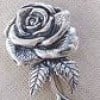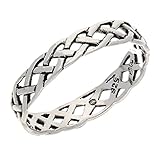Silver Celtic Rings
Celtic Jewelry, with it's intricate patterns of knots and crosses, was developed between 2000 BC and 500 AD in Western Europe - the British Isles, Gaul and Galicia in northern Spain were the Celtic heartlands before the Germanic tribes (Angles, Saxons and Franks) invaded Britain, France and Spain.
Celtic jewelers in particular worked in silver and most Celts of this period owned at least a silver celtic ring (and if they were wealthy, bracelets, necklaces, and armbands too).
Silver Celtic Knot Rings
Celtic knots start appearing in Celtic jewelry around 450 AD, when Christian monks first went to Ireland to convert the pagan Celts. The knot design also appears in illuminated manuscripts in the 7th century.
The Celtic knot, also known as the endless knot or "mystic" knot, is meant to symbolise no beginnings or endings, and thus to symbolise eternity.
Many people in the past believed that the interlocking pattern warded off evil and bad luck and wore the rings as charms. Modern wearers choose the rings simply because the patterns are so beautiful.
The Claddagh Ring
The Claddagh ring (pronounced klä d ä) is a ring formed of two hands clasping a heart, with a crown on top, symbolising fidelity. It was invented about 300 years ago by a fisherman called Richard Joyce, who lived in the village of Claddagh, which is just outside Galway in Ireland.
Legend says that just before he was due to be married, he was captured by pirates while out fishing, and sold into slavery in Algeria where he became the slave to a Moorish goldsmith, who taught him the craft of jewelry making. Pining for his fiance, he created the ring. In 1698, he was released and returned to Claddagh. His sweetheart had waited for him, and he presented her with the ring, married her and spent the rest of his life making jewelry.
If the Claddagh ring is worn on the left hand, it signifies that the wearer is married. If worn on the right hand with the crown pointing towards the fingernails, the wearer is in a serious relationship. If the crown points to the base of the fingers, the wearer is not serious.
If you want to know more about Celtic jewelry, click here.









